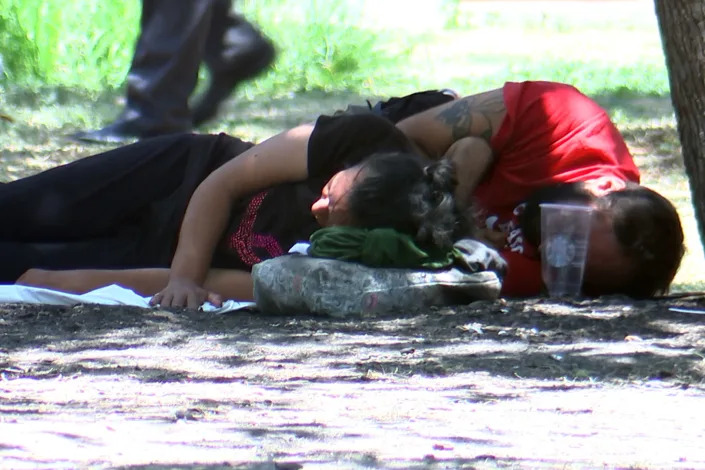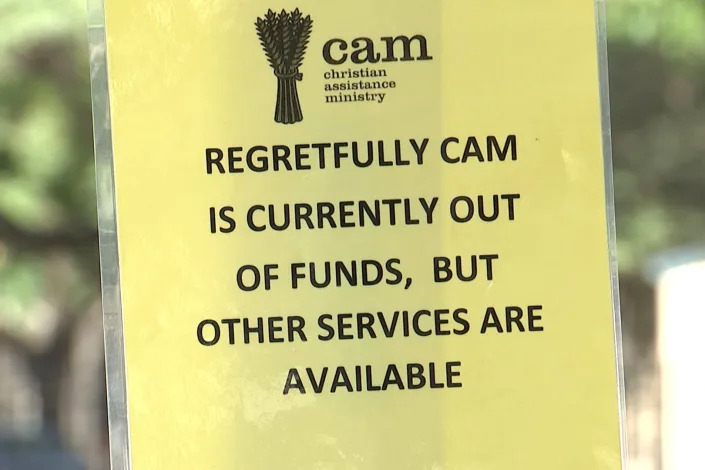With his Venezuelan ID card, recently donated shoes and clean clothes, Adri Fernández is trying to start his American dream, alone.
Unlike the families and unaccompanied children who have been the main groups migrating to the U.S. this past decade, Fernández is one of the single adults arriving without family to turn to or contacts willing to help him get on his feet after he was released by U.S. Immigration and Customs Enforcement.
Fernández, who currently awaits scheduled hearings regarding his request for asylum, ended up in San Antonio because that’s where immigration officials decided he should go. A stranger drove him the nearly 200 miles from Laredo, Texas.
“When I arrived, they started asking me at Immigration where I am going. With all sincerity, I said I had no relatives here and that I had nowhere to go,” Fernández, 26, said. “So they gave me an address and told me: Does San Antonio work for you? I told him yes.”

San Antonio, as well as other cities, including Washington, D.C., and New York, are grappling with how to help the growing number of asylum seekers like Fernández.
“I don’t have a dollar to live on,” he said, as one of 15 migrants in similar circumstances who spoke to Noticias Telemundo Investiga.
But Fernández said he trusts “the American dream, which is to work and lift your back.”
Fernández’s first appointment with ICE is on Aug. 25 and his first hearing with the immigration judge will be on March 5, 2024, both in San Antonio. Failing to show up could lead to a decision to deport him without him having his day in court.
Home is where ICE sends you
Catholic Charities, part of the San Antonio archdiocese, estimates that about half the migrants it serves are single adults with no connections in the U.S. The organization said it has seen more of these arrivals in the past few years.
According to the American Immigration Council, single adults were responsible for more than half of all border apprehensions last year. That increase followed a lull in single adults crossing the border from Mexico at the time of the Great Recession, a trend that continued for about a decade, followed by a rise in migration of unaccompanied minors and families with children.
Asylum seekers who are awaiting their scheduled hearings generally arrive in cities like San Antonio with documents from ICE that say “currently residing at” and an address.

A check of the addresses by Noticias Telemundo Investiga found they generally belonged to nonprofit organizations or U.S. contacts provided by the migrants; some contacts didn’t want to take responsibility for them or didn’t answer when a reporter called the corresponding phone numbers.
An ICE spokesperson in San Antonio said the cities to which it sends migrants, and the specific addresses, were decided on a case-by-case basis.
“Individuals released from ICE custody make transportation arrangements and have a temporary support plan before their release,” the ICE spokesperson said in an email.
The spokesperson said ICE coordinates with local nonprofit organizations to give migrants “temporary shelter, food, water, clothing and transportation after their release” but didn’t specify as to the situation in San Antonio.
Adri Fernández, the Venezuelan asylum seeker, said the address he was given was an office building that housed a nonprofit group, which told him it could provide him with neither shelter nor help at the time.
“They tell me — they don’t have any help for Venezuelans right now,” he said.
He found his way to a plaza in central San Antonio where others who have migrated congregate, and where a church offers them a place to sleep at night.
Catholic Charities said it has found several of its San Antonio addresses appearing on migrants’ documents, although neither the government nor asylum seekers have asked permission beforehand to use these addresses.
“We have heard of people showing up at our agencies without notifying them beforehand, but that varies by place. The Department of Homeland Security makes that decision, but we don’t know exactly where that’s happening,” said Patricia Cole, Catholic Charities national spokesperson.
Catholic Charities in San Antonio directs the migrants to shelters, hotels or churches in the city. It helps buy migrants tickets, but demand is high and paying for them poses a challenge, the group said.
“We don’t leave anyone on the street. We send them wherever we can,” said Antonio Fernández, president and CEO of Catholic Charities in San Antonio. But he added that the group, which receives federal grants and private donations, can’t provide long-term shelter.
The organization will be in charge of a new shelter, and it expects to receive Federal Emergency Management Agency funds to run it, according to Fernández.
San Antonio receives about 600 migrants a day, and about 500 of them need accommodation for at least that first night, said Roland Martinez, public relations manager for the city of San Antonio. Since April 2021, some 185,000 migrants have passed through San Antonio. Most continue on to other parts of the country.
For weeks, migrants released by ICE at the border or in San Antonio have arrived at the airport or the Greyhound bus station downtown.
On July 7, San Antonio opened a temporary center to welcome those who have recently arrived for a few hours while they wait for their connections to other parts of the country.
The city characterizes it as “a safe and welcoming place for migrants traveling through San Antonio.”
After two weeks, according to Noticias Telemundo, the center had to close because it was at capacity, and city officials were requesting more help from the federal government.
At Christian Assistance Ministry in San Antonio, two brothers stood in a line of people who had recently migrated — along with city residents who were currently homeless — to get breakfast to go, a shower, and clean clothes.
Executive Director Dawn White-Fosdick said she believes the higher number of people arriving in the U.S. has outstripped charitable resources in border towns, so they are being sent to San Antonio.
Source: OEM



